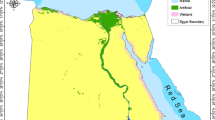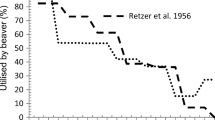Abstract
A geographical information system (GIS)-based model, including major parameters of topography, hydrology and vegetation, was developed to assess suitable habitats for beavers in the Federal Province of Salzburg, Austria. BeaversCastor fiber Linnaeus, 1758 are on the verge of their distribution in the study area. At present, the 18 existing colonies show a rather scattered pattern, which suggests that the sub-population has not yet reached its carrying capacity, and a rapid growth phase as seen in other regions is expected. Suitable habitats have been calculated for the regions Alpenvorland, Salzburger Becken, Kalkvoralpen and Kalkhochalpen. Here optimal habitat is covering 429 ha (meeting all requirements of beavers) and suboptimal habitat is covering 187 ha (meeting all requirements except a winter food source). This represents 3.4% optimal and 1.5% sub-optimal habitat of the total available area. There are 13–14 suitable regions large enough to host at least one beaver colony. A total of 31 (23–51) colonies were calculated by the model. Based on the current sub-population of 18 colonies (36–100 animals), an average increase of 72% was expected. In an intensively managed landscape, beaver-human conflict should be anticipated and management policies established. Continuous assessment of suitable, unsuitable and sensitive habitats, extending existing conservation areas and river bank habitats, and pursuing protective measures against individuals causing conflicts are presented for the study areas.
Similar content being viewed by others
References
Allen A. W. 1983. Habitat suitability index models: Beaver U.S. Fish Wildl. Serv. FWS/OBS-W10.30 Revised: 1–20.
Bundesamt für Eich- und Vermessungswesen 2001. Gewässernetz ÖK 1:50 000. Bundesamt für Eich- und Vermessungswesen, Wien, Austria.
Bundesamt für Eich- und Vermessungswesen 2002. Digitales Geländemodel 1:15 000. Bundesamt für Eich- und Vermessungswesen, Wien, Austria.
Bundesministerium für Land- und Forstwirtschaft, Umwelt und Wasserwirtschaft. 2004. Hydrographisches Jahrbuch von Österreich 2001, 109: 1–652.
Collen P. and Gibson R. 2001. The general ecology of beavers (Castor spp.), as related to their influence on stream ecosystems and riparian habitats, and the subsequent effects on fish — a review. Reviews in Fish Biology and Fisheries 10: 439–461.
CORINE Land Cover 2000. Umweltbundesamt, Wien, Austria.
Czech A. and Lisle S. 2003. Understanding and Solving the Beaver (Castor fiber L.)-Human-Conflict: An Opportunity to Improve the Environment and Economy of Poland. Denisia 9: 91–98.
Dezhkin V. 1999. Beaver in the modern world: necessity of the population management on the national and the international level. [In: First European-American Beaver Congress. P. E. Busher and Y. Gorshkov, eds]. Transactions of the Volga-Kama National Nature Zapovednik, Kazan 4: 11.
Djoshkin W. and Safonow W. 1972. Die Biber der Alten und Neuen Welt. Neue Brehm Bücherei, Wittenberg-Lutherstadt 437: 1–168.
ESRI. 2004. ArcGIS, version 9.0. Environmental Systems Research Institute Inc., Redlands, California.
Fielding A. H. and Bell J. F. 1997. A review of methods for the assessment of prediction errors in conservation presence/absence models. Environmental Conservation 27: 38–49.
Fustec J., Lode T., Lejacques D. and Cormier J. P. 2001. Colonization, riparian habitat selection and home range size in a reintroduced population of European beavers in the Loire. Freshwater Biology 46: 1361–1371.
Geiersberger I. 1986. Der Lebensraum des BibersCastor fiber L. in Bayern. Säugetierkundliche Mitteilungen 33: 125–170.
Halley D. J. and Rosell F. 2002. The beaver’s reconquest of Eurasia: status, population development and management of conservation success. Mammal Review 32: 153–178.
Hartman G. 1994. Long-term population development of a reintroduced beaver (Castor fiber) population in Sweden. Conservation Biology 8: 713–717.
Heidecke D. 1989. ökologische Bewertung von Biberhabitaten. Säugetierkundliche Informationen 3: 13–28.
Heidecke D., Dolch D. and Teubner J. 2003. Zur Bestandsentwicklung vonCastor fiber albicus Matschie, 1907 (Rodentia, Castoridae). Denisia 9: 123–130.
Hirzel A., Hausser J. and Perrin N. 2002. Biomapper, version 2.1. Laboratory for Conservation Biology, University of Lausanne, Lausanne.
Jäger P., Mühlmann H. and Raudaschl S. 2004. Hydromorphologische Fließgewässeraufnahme von Salzburg 2003. Erhebung ökologisch signifikanter hydromorphologischer Belastungen im Sinne der WRRL. Reihe Gewässerschutz 9: 1–70.
Jenkins S. H. and Busher P. E. 1979. Castor canadensis. Mammalian Species 120: 1–8.
Kalleder S. 1982. Die Wiedereinbürgerung des Bibers und ihr Einfluß auf das Auwaldbiotop am unteren Inn. Mitteilungen der Zoologischen Gesellschaft Braunau 4: 1–42.
Kollar H.-P. and Seiter M. 1990. Biber in den Donau-Auen östlich von Wien. Eine Studie erfolgreicher Wiederansiedelung Umwelt. Schriftenreihe für Ökologie und Ethologie 14: 1–75.
Krebs U. 1984. Analyse der monatlichen Fällmenge einer isolierten Gründerpopulation des BibersCastor fiber L. in den Donauauen bei Wien. Säugetierkundliche Mitteilungen 31: 209–222.
Landis R. J. and Koch G. G. 1977. The measurement of observer agreement for categorical data. Biometrics 33: 159–174.
Land Salzburg 2003. Digitaler Katasterplan des Bundeslandes Salzburg 1:1000. Salzburg, Austria.
Maringer A., Widerin K. and Slotta-Bachmayr L. (in press). Die Bewertung der Salzburger Salzachauen (Salzburg, österreich) als Lebensraum für den Biber (Castor fiber L.). Bericht der naturwissenschaftlich medizinischen Vereinigung Salzburg.
McCullagh P. and Nelder J. A. 1989. Generalized Linear Models. Monographs on Statistics and Applied Probability 37. Chapman and Hall, London. 1–511.
Müller D., Slotta-Bachmayr L., Bergthaler G., Hofrichter R., Hüttmeir U., Kössner G., Kyek M., Lindner R., Loidl B., Rathmayr U., Schnaitl M., Stürzer S., Waubke M. and Werner S. 1994. Ökologie und Verbreitung des Bibers (Castor fiber) an der Salzach (österreich, Bayern). Beiträge zur Naturkunde Oberösterreichs 2: 119–129.
Plass J. 2003. Der Biber (Castor fiber Linnaeus 1758) in Oberösterreich — historisch und aktuell. Denisia 9: 53–76.
Recker W. 1997. Die Nahrungsökologie des Elbebiber, Castor fiber albicus Matschie 1907, zwischen oberer Havel, Finow und Welse unter besonderer Berücksichtigung seiner Einwirkung auf die Gehölze. Säugetierkundliche Mitteilungen 39: 115–145.
Reichholf J. 1976. Die Ausbreitung eingesetzter Biber (Castor fiber L.) am unteren Inn. Mitteilungen der Zoologischen Gesellschaft Braunau 2: 361–368.
Rosell F., Parker H. and Steifetten Ř. 2006. Use of dawn and dusk sight observations to determine colony size and family composition in Eurasian beaverCastor fiber. Acta Theriologica 51: 107–112.
Rosenau S. 2003. “Bibermanagementplan” — Entwicklung eines Schutzkonzeptes für den Biber (Castor fiber L.) im Bereich der Berliner Havel. Zwischenbericht: 1–8.
Schamberger M. L. and O’Neil L. J. 1986. Concepts and constrains of Habitat-Model testing. [In: Wildlife 2000. Modelling habitat relationship of terrestrial vertebrates. J. Verner, M. Morrison and C. J. Ralph, eds]. University of Wisconsin Press, Madison: 5–10.
Schwab G. 1994. Biber (Castor fiber L.) — Systematik, Verbreitung, Biologie. Schriftenreihe des Bayerischen Landesamtes für Umweltschutz 128: 5–8.
Schwab G., Dietzen W. and v. Lossow G. 1992. Biber in Bayern. Entwicklungskonzept zum Schutz des Bibers in Bayern. Bayerisches Landesamt für Umweltschutz, München: 1–104.
Schwab G., Dietzen W. and v. Lossow G. 1994. Biber in Bayern — Entwicklung eines Gesamtkonzeptes zum Schutz des Bibers. Schriftenreihe des Bayerischen Landesamtes für Umweltschutz 128: 9–44.
Schwab G. and Lutschinger G. 2001. The return of the beaver (Castor fiber) to the Danube watershed. [In: The European beaver in a new millennium. A. Czech and G. Schwab, eds]. Carpathian Heritage Society, Kraków, Bialowieza, Poland: 47–50.
Schwab G. and Schmidbauer M. 2003. Beaver (Castor fiber L., Castoridae) management in Bavaria. Denisia 9: 99–106.
Seefeldner E. 1961. Salzburg und seine Landschaften: eine geographische Landeskunde. Das Bergland-Buch, Salzburg: 1–373.
Sieber J. 1989. Biber in Oberösterreich. Eine aktuelle Bestandsaufnahme an Inn und Salzach. Jahrbuch des Oberösterreichischen Musealvereins 134: 277–285.
Sieber J. 1999. The Austrian Beaver,Castor fiber, Reintroduction program. [In: Beaver Protection, Management, and Utilization in Europe and North America. P. E. Busher and R. M. Dzieciolowski, eds]. Kluwer Academic / Plenum Publishers, New York: 37–42.
Sieber J. 2003. Wieviele Biber (Castor fiber L.) sind zuviel? Denisia 9: 3–12.
Sieber J. and Bauer K. 2001.Castor fiber — Europäischer Biber undC. canadensis — Kanadischer Biber. [In: Die Säugetierfauna Österreichs. F. Spitzenberger, ed]. Grüne Reihe des Bundesministeriums für Land- und Forstwirtschaft, Umwelt und Wasserwirtschaft, Graz: 366–374.
Slotta-Bachmayr L. 2005. Verteilung und Gefährdung von Klammen im Bundesland Salzburg. unpubl. Report, Landesumweltanwaltschaft Salzburg: 1–24.
Slotta-Bachmayr L. and Augustin H. 2003. Der Biber (Castor fiber L.) im Bundesland Salzburg: Situation und Verbreitung nach der Wiedereinbürgerung vor 20 Jahren. Denisia 9: 85–90.
South A., Rushton S. and Macdonald D. 2000. Simulating the proposed reintroduction of the European beaver (Castor fiber) to Scotland. Biological Conservation 93: 103–116.
SPSS. 2001. SPSS, version 11.0.1 for Windows. SPSS Inc., Chicago, Illinois.
Stocker G. 1985. Biber (Castor fiber L.) in der Schweiz. Probleme der Wiedereinbürgerung aus biologischer und ökologischer Sicht Eidgenössische Anstalt für forstliches Versuchswesen, Birmensdorf. Bericht 247: 1–149.
Stockwell D. R. B. and Peters D. P. 1999. The GARP modelling system: Problems and solutions to automated spatial prediction. International Journal of Geographic Information Systems 13: 143–158.
USFWS United States Fish and Wildlife Service. 1980. Habitat Evaluation Procedure (HEP) ESM 102. Release 2–80.
Widerin K., Maringer A. and Slotta-Bachmayr L. 2005. Verbreitung und Bestand des Bibers (Castor fiber, Rodentia, Mammalia) in der Salzachau zwischen Siggerwiesen und Oberndorf (Salzburg, Österreich). Linzer biologische Beiträge 37: 787–796.
Wittmann H., Pilsl P., Siebenbrunner A. and Heiselmayer P. 1987. Verbreitungsatlas der Salzburger Gefäßpflanzen, Sauteria 2: 1–403.
Zahner V. 1994. Der Biber — ein Waldtier — Überlegungen zu seiner Wiedereinbürgerung aus forstlicher Sicht. Schriftenreihe des Bayerischen Landesamtes für Umweltschutz 128: 57–60.
Zimmermann, F. 2004. Conservation of the Eurasian lynx (Lynx lynx) in a fragmented landscape — habitat models, dispersal and potential distribution. PhD thesis, University of Lausanne, Lausanne: 1–193.
Author information
Authors and Affiliations
Additional information
Associate Editor was Magdalena Niedzia⦊kowska.
Rights and permissions
About this article
Cite this article
Maringer, A., Slotta-Bachmayr, L. A GIS-based habitat-suitability model as a tool for the management of beaversCastor fiber . Acta Theriol 51, 373–382 (2006). https://doi.org/10.1007/BF03195184
Received:
Accepted:
Issue Date:
DOI: https://doi.org/10.1007/BF03195184




